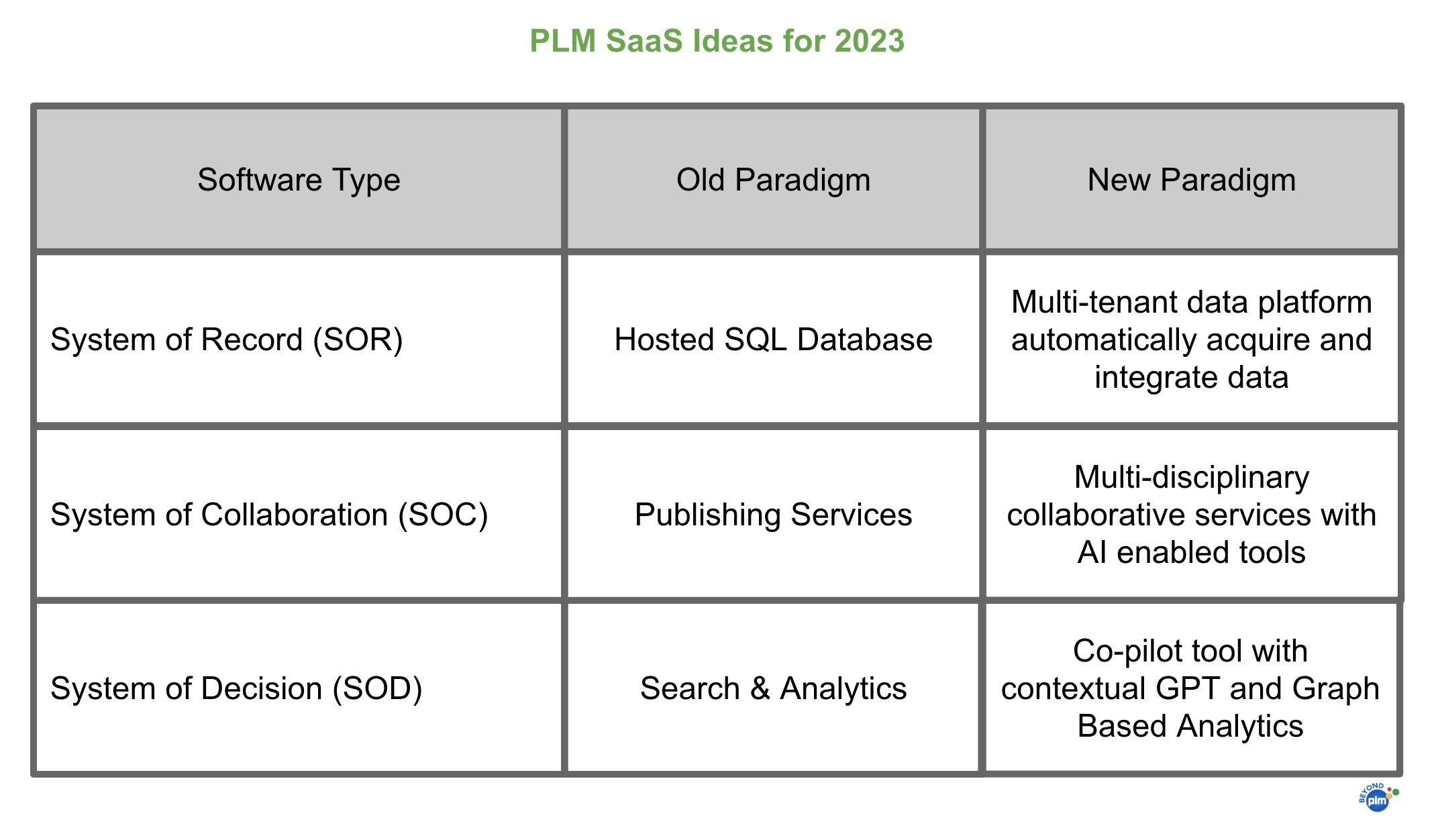
The summer is at its peak. It is a great time to slow down to reflect on what happened so far with the PLM business. SaaS became a mainstream way to deliver software these days. From the early days of Salesforce.com and many other pioneers of SaaS business in different industries, SaaS is not stopping. So, it is a great time to check around and to see where we came so far and, more importantly where we can go now – what are PLM SaaS opportunities and what are the problems of PLM software that can be solved by using modern SaaS and cloud technologies.
PLM SaaS Status Quo
Let’s start by discussing where we are today. Cloud and SaaS in PLM as application for manufacturing companies, was initially met with skepticism and security concerns. You should remember these discussions back in the 2010s. Security and flexibility were the main two defending lines of PLM vendors, but the shift was already felt by the end of the 2010s. COVID accelerated the transition and triggered a real need for companies to adopt cloud technologies and SaaS models. Existing PLM leaders are super conservative by nature of selling their solutions to the biggest and largest manufacturing companies in the world, but even so, all of them now are moving to the future of SaaS (PTC Windchill+, Siemens TeamcenterX, Dassault Systemes 3DX, Aras Enterprise SaaS). Cloud and digital transformation are supported by other leading vendors in the world of engineering, manufacturing, and construction software. We can see how companies such as Autodesk, Hexagon, Bentley Software, and some others are also developing their SaaS product portfolio. ERP vendors and industrial companies are also actively looking at developing and acquiring technologies and vendors with SaaS products. Both leading ERP vendors (SAP HANA Cloud and Oracle Fusion Cloud) are building cloud portfolios. Also, industrial manufacturers (eg. Rockwell Automation, GE Digital, and others) are acquiring companies to support their software product lifecycle management and digital transformation. SaaS businesses companies are among leaders and high performers of G2 PLM Grid.
To sum up a status quo, we can see that all PLM vendors are actively promoting SaaS products (and platforms), while the following 3 fundamental elements of the cloud strategy can be defined as common between all of them:
- Runs using cloud infrastructure (public or private).
- Subscription-based
- Integrated with other tools in a much easier way
The implementations and business models are slightly different. Some companies are using hyperscalers such as AWS, Azure, or GCP. Dassault System, instead, is using their own acquired Outscale infrastructure. Most of the products and solutions is available via annual and multi-year subscriptions. For most of CAD and PLM SaaS, you need to talk to sales in order to buy (PTC Onshape, Propel PLM, DuroLabs). Some of them are available for online purchase (eg. Autodesk Fusion360, OpenBOM). Integration is one of the most painful topics. While modern SaaS tools provide ways easy integrate, older products (even hosted in the cloud) still very limited to integrate and many situations require a special effort and extended subscriptions to connect with other applications.
PLM SaaS Evolutions
Although we can see all mindshare PLM vendors have also been actively supporting their SaaS strategies, we have to admit that it is still very far from being completed. Hosting existing PLM platforms on hyperscalers (AWS, Azure, GCP) was a relatively easy task, but the robustness of these solutions can be questionable and the ability of vendors to provide cost-effective and scalable solutions to support a broad range of industrial companies from super small to enterprise and supply chain networks is not guaranteed. Keep in mind, the newest PLM software platforms were developed 20+ years ago, using a single tenant model and their administration requires major effort and might not scale to support modern manufacturing processes and environments.
Modern data management technologies, multi-tenant solutions, integration capabilities, collaboration, AI technologies, and many others can help newcomers in the PLM world to offer new products and services to offer more scale, flexibility, intelligence, and adaptivity compared to the first generated of hosted PLM platforms. It can explain crazy multipliers some PLM companies paid already for modern CAD and PLM software technological platforms (while not all numbers are public, PTC acquiring Onshape for approximately $470M is probably the best example, but there are others too).
Over the last ten years, we’ve seen PLM SaaS models enhance collaboration, streamline processes, and provide unprecedented visibility into product lifecycles. But what of the future? In an era of growing digital complexity and rising customer expectations, what new directions might the PLM SaaS journey take?
3 PLM Ideas for SaaS in 2023
To explain my ideas in PLM SaaS, I want to use the following table. The common theme where I’m taking my ideas is related to three main trends in the SaaS world these days – (1) data scale, (2) connectivity, and (3) Artificial Intelligence and Generative AI. Data is one of the most fascinating things in the world. If you look behind, you can see that the most powerful business in the world that was built for the last 10-15 years focused on how to put data at the center of their business processes. With this thing in mind, let me show you what I can see as promising trends and opportunities in the PLM business in the coming years.
I want to thank you my friends and colleagues that discussed many innovative ideas about PLM and SaaS for the last few months – my long time blogging colleague Jos Voskuil (also known as a Virtual Dutchman) Helena Gutierrez of Share PLM, Adam Keating of CoLab and many others.
To put a framework behind PLM SaaS system innovation, I created a table with three levels of systems – System of Records, System of Engagement, and System of Decisions. System of Record is usually the system that keeps the data about product, changes, etc (eg. PDM, PLM). System of Engagement is the system that people use all the time to communicate (viewing, redlining, chat, etc). System of Decision is the system (or systems) that companies and people use for analysis and decision support (eg. search, dashboard, analysis). To learn more about it, check my previous blog about it here.
In the table below I want to show a paradigm shift that will be happening in SaaS PLM.

System of Records (SOR)
The system of records is the most fundamental one. For many years, PLM was not more than a central database for the company where you can put the data and store it safely. The interaction with this database was not only perfect. Most companies used it for engineering data storing CAD files and managing BOM changes. Moving beyond 2023, data management platforms are becoming much more than just a database for a company. Current products are too limiting because they are not allowed to store data and share it with contractors and supply chains. Also, the demand for data integration is growing. The opportunity to gather public information (eg. supplier, cost, standard, etc) and to make it available for companies using modern integration tools
System of Collaboration (SOC)
Collaboration is the old word in the lexicon of PLM software. For most of the use cases, collaboration means someone else can get access to the data after engineers created it. So-called “publishing” service is useful, but limiting. What we learned from many modern tools, is to collaborate in 2023 means to work interactively, no matter where people work and how they engage in the process of designing and building products. Such systems can provide much more than just publishing and visualization, but also capture intent and history of communication that can become super valuable data. Knowing who made a change, when, and why in design, BOM changes, supply chain, and many other use cases can be a source of process improvement.
System of Decision (SOD)
Most of the “decision-making” in traditional PLM software was about reporting and dashboarding. It still gives a lot of opportunities because of current PLM software user experience is complex, licensing is expensive, and getting data out of PLM systems for analysis is an opportunity. But we have more interesting things that are coming to PLM space. With a large wave of generative AI, graph-based data science, and other tools, the idea to build co-pilot tools that can use automatically generated models you can ask about something you need (for example what is the best supplier, or what are the top three most expensive components in a product company need to improve, etc.)
What is my conclusion?
PLM SaaS trajectory is not set in stone. For the last 20+ years, PLM software was growing by expanding its functional scope, getting new capabilities, and improving engineering efficiency. The new wave of PLM software will help companies to improve the effectiveness of their decisions using data. Product lifecycle management, product data management, supply chain management, process management, document management, manufacturing planning, and many other disciplines and tools used in the product development process must be improved using data about products, customer feedback, production process, supply chain product quality metrics from customers and many others to help companies to build the new data management, collaboration, and analytic capabilities.
I hope you can see the trend I outlined in this blog. PLM SaaS 2023+ trajectory is to build around data (not functions) to help manufacturing companies operate more efficiently and make the right decisions based on accurate data.
Just my thoughts…
Best, Oleg
Disclaimer: I’m co-founder and CEO of OpenBOM developing a digital cloud-native PLM platform that manages product data and connects manufacturers, construction companies, and their supply chain networks. My opinion can be unintentionally biased.












